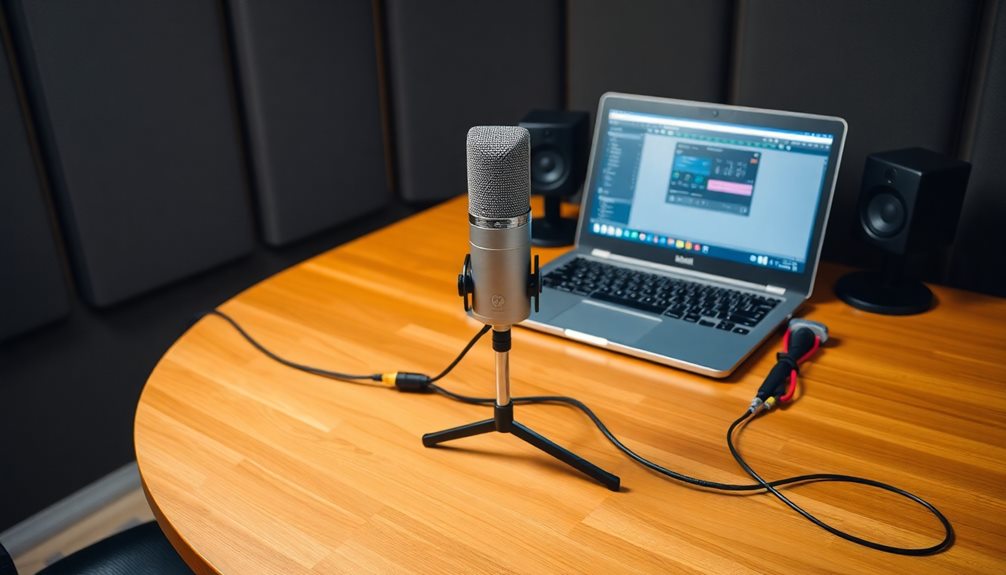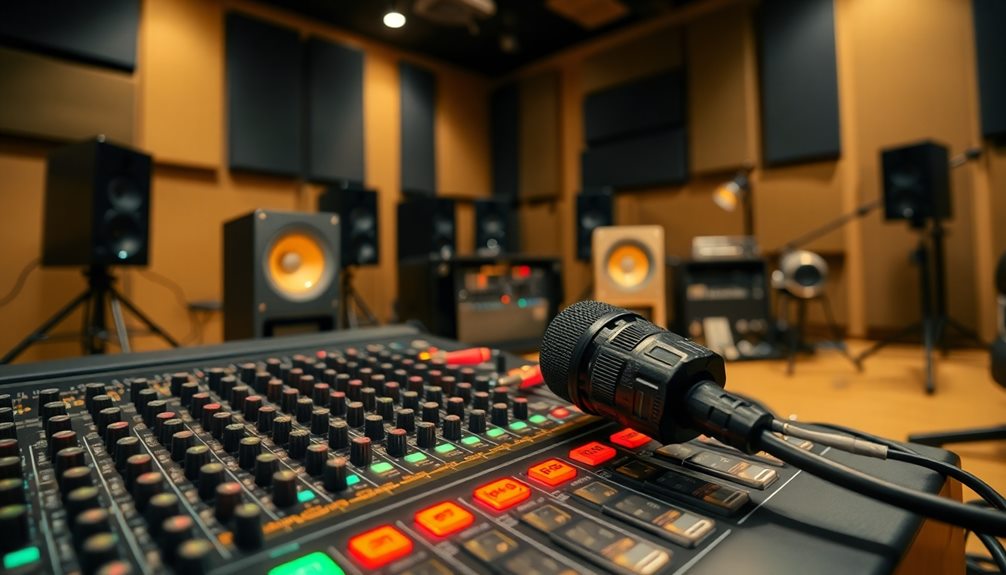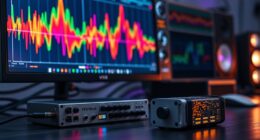A condenser microphone's your go-to for capturing amazing sound! It's perfect for music studios and podcasts because it picks up every little detail in voices and instruments. You'll love using it for recording songs, voiceovers, or even while chatting on your favorite streaming platform. These microphones also shine in film production, as they can precisely capture dialogue. They're highly sensitive, so they work best in quiet settings where you want clarity. If you're curious about different types and models available, there's so much more exciting information to explore!
Key Takeaways
- Condenser microphones are ideal for studio recording, capturing rich vocal details and nuances in instruments.
- They are commonly used in live sound settings to enhance audio quality for orchestras and delicate instruments.
- Small diaphragm models excel in field recording, accurately capturing ambient sounds and environmental details.
- Shotgun microphones are utilized in film and broadcast to isolate dialogue with a focused pickup pattern.
- They are popular for voiceovers and podcasts, providing clear sound reproduction for engaging content.
Overview of Condenser Microphones
When you think about capturing high-quality audio, condenser microphones often come to mind due to their unique design and functionality.
These microphones are special because they've a diaphragm that vibrates in response to sound waves. This makes them highly sensitive to detail and nuance, which is perfect for recording. With their wide frequency response, condenser microphones are ideal for studio recording, especially when you want to record vocals or acoustic instruments.
You can find different types of condenser microphones, like large-diaphragm microphones, which add warmth to your recordings. They require phantom power, usually 48V, to operate effectively. This external power helps enhance the audio fidelity, making your recordings sound rich and clear.
However, it's important to remember that condenser microphones are best used in controlled environments, like studios. They're not as durable as dynamic microphones, so they can struggle in noisy or rough settings.
How Condenser Microphones Work
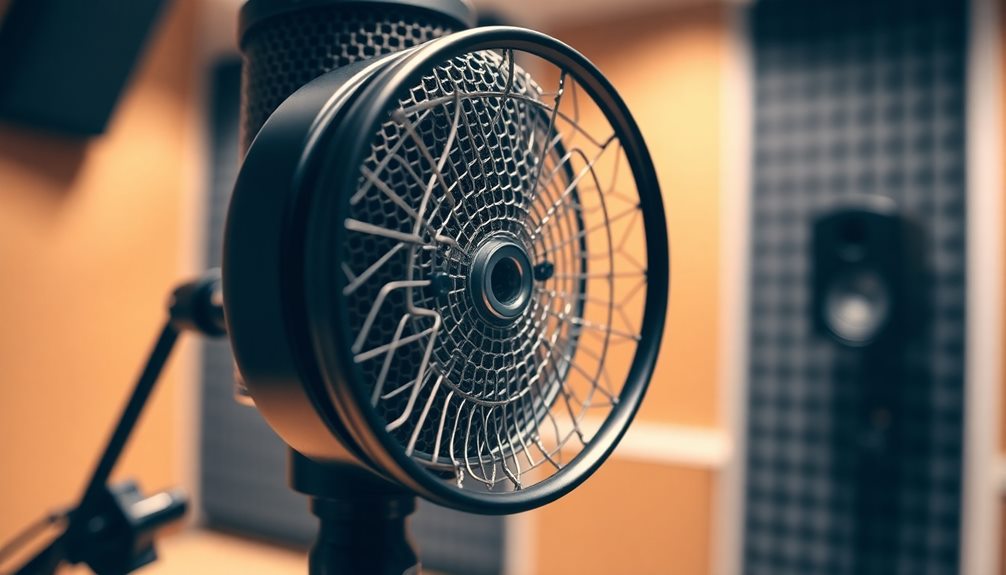
Condenser microphones function by utilizing a diaphragm that vibrates in response to sound waves, creating changes in capacitance between two plates—one movable and one fixed. This movement alters the distance between the plates and generates an electrical signal. To make this work, you'll need an external power source, usually 48V phantom power. This power helps polarize the diaphragm, allowing the microphone to pick up sound accurately.
One of the coolest things about the sensitivity of condenser microphones is how they capture a wide frequency range. This means they can hear both high and low sounds very well! Their thin, conductive diaphragm reacts beautifully to sound pressure, making studio recordings sound richer and more detailed compared to other microphones.
When you connect a condenser microphone to an audio interface or mixer, you typically use an XLR cable. This cable helps transmit that boosted signal from the microphone's preamp, ensuring you get the best sound quality possible.
Common Applications and Uses
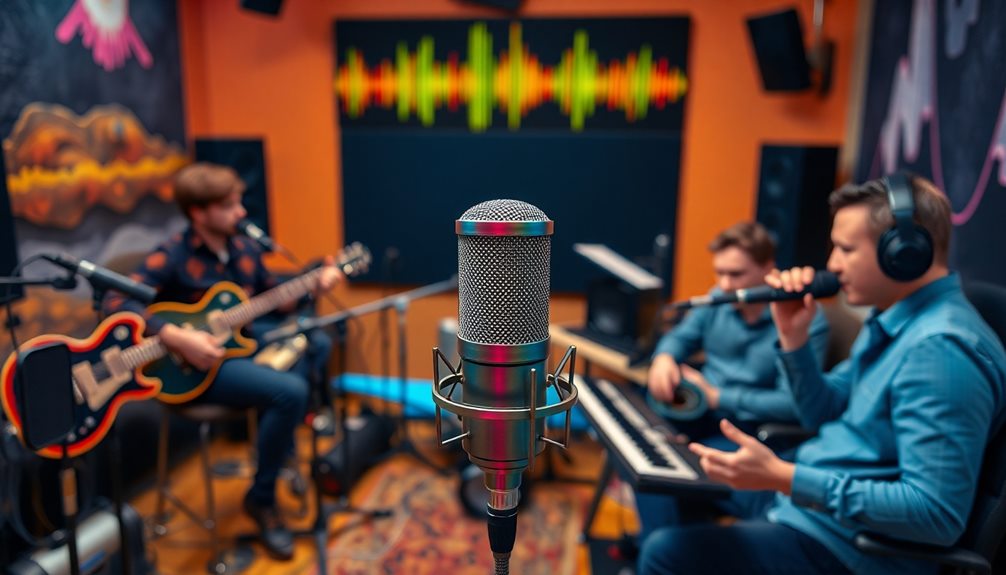
In the world of audio production, condenser microphones play a pivotal role across various applications. You'll find them in studio recording, capturing both vocals and instruments with remarkable detail. Their high sensitivity makes them perfect for voiceovers and podcasts, where clear sound keeps listeners engaged.
Here's a quick look at some common uses:
| Application | Description |
|---|---|
| Studio Recording | Ideal for vocals and instruments, capturing rich details. |
| Live Sound | Perfect for orchestras and delicate instruments, enhancing sound quality. |
| Field Recording | Small diaphragm condensers capture ambient sounds accurately. |
| Shotgun Microphone | Used in film and TV for isolating dialogue with directional capabilities. |
| Voiceovers & Podcasts | Clear sound reproduction is key for engaging your audience. |
Whether you're in a studio or out in the field, condenser microphones excel in bringing out the best in audio. They truly shine in capturing the different layers of sound, making them indispensable for creators like you. So, next time you pick up a condenser microphone, remember its incredible versatility!
Advantages of Using Condenser Microphones
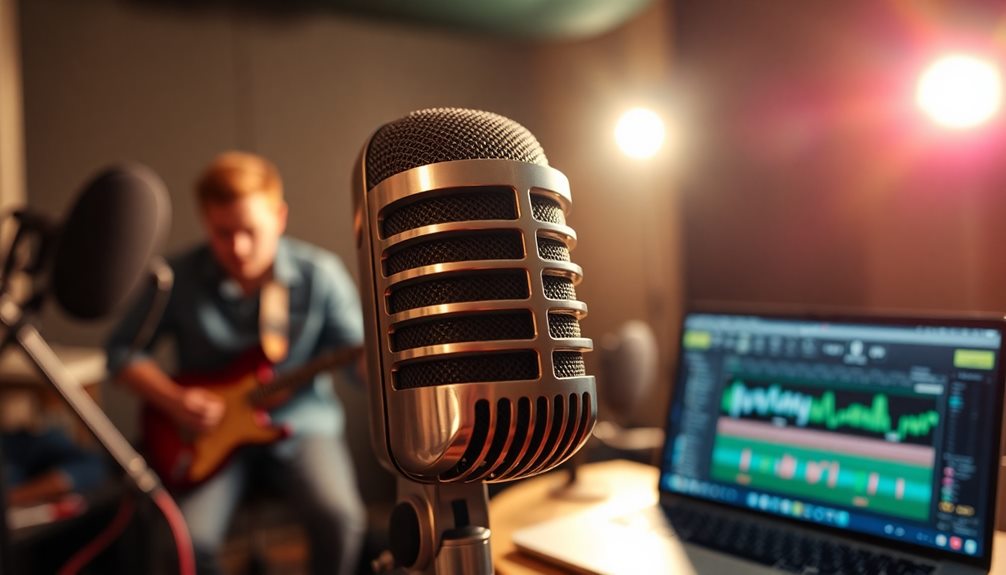
Harnessing their exceptional sensitivity, condenser microphones offer significant advantages for audio professionals and enthusiasts alike. These microphones are perfect for recording vocals and acoustic instruments in studio settings. Their ability to capture intricate details means you'll get high-quality sound that brings your recordings to life.
One of the standout features of condenser microphones is their wide frequency response. This allows them to reproduce both high and low frequencies accurately, enhancing the overall audio quality. You'll notice that recordings sound richer and more dynamic.
Plus, with their low self-noise, these microphones minimize background noise, ensuring that every subtle nuance shines through.
Another fantastic benefit is their versatility. Whether you're podcasting, doing voiceovers, or working on film production, condenser microphones excel in many applications where high-quality audio capture is essential.
They often include internal preamplifiers, which provide a stronger output signal. This means you can use less gain when recording, reducing the risk of distortion.
Disadvantages of Condenser Microphones
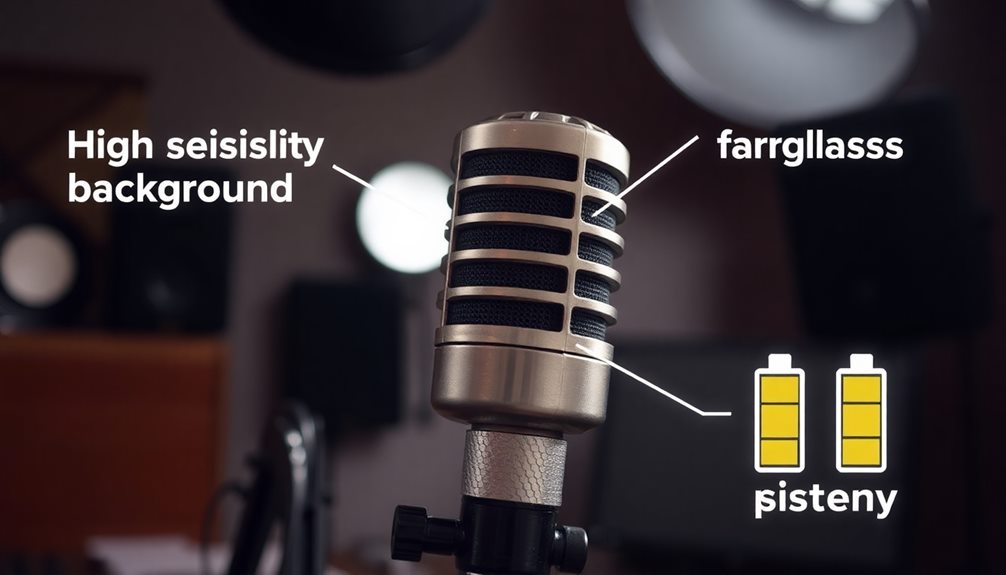
While condenser microphones have some amazing advantages, they also come with a few challenges.
They can be really sensitive to loud sounds, which might cause feedback during a live show.
Plus, they need special power and can be pricier, making them a little tricky for beginners or in certain settings.
Environmental Sensitivity Issues
Condenser microphones, known for their exceptional sensitivity, often face significant environmental sensitivity issues. This means that while they can capture amazing sound, they can also pick up unwanted background noise. If you're in a noisy place or a space that isn't acoustically treated, you might hear distractions that you don't want in your recordings.
Another challenge is feedback issues. If you set your microphone near loudspeakers, you could face annoying squeals and echoes. Changes in humidity and temperature also play a big role in how they perform. These factors can change the microphone's sound quality over time.
Plus, condenser microphones need phantom power to work, which limits where you can use them. Imagine being in a cool location without power; that could be a problem!
Their delicate construction adds another layer of concern. They're not as durable as dynamic microphones, which means they can be easily damaged if not handled carefully.
In short, while condenser microphones are fantastic tools, you need to be aware of these environmental sensitivity issues to make the most of their sound quality!
Power Requirement Limitations
Environmental sensitivity isn't the only challenge you'll face with condenser microphones. One major issue is that these microphones require phantom power, which is an external power source, usually 48V. This can limit where and how you use them, especially in portable recording setups.
Here's a quick look at some of the power limitations:
| Aspect | Details | Impact |
|---|---|---|
| Power Requirement | Requires 48V phantom power | Not all devices provide this power |
| Compatibility | May not be compatible with all setups | Limits your options |
| Setup Process | Complicated due to extra power needs | Slows down quick recordings |
| Loss of Audio Input | Malfunctions can cause complete audio loss | Leads to recording failures |
If you're recording on the go or in mobile applications, the need for phantom power can make things tricky. You might find yourself needing to switch to battery-operated or dynamic microphones, which are easier to use. If the phantom power accidentally turns off, you'll face a frustrating loss of audio input. So, while condenser microphones are fantastic, keep these power requirements in mind!
Cost and Complexity Factors
When investing in audio equipment, you'll quickly notice that condenser microphones can be a hefty financial commitment. They often cost more than dynamic microphones, with prices starting around $100 and soaring beyond $3,000 for premium models. This makes them a significant investment!
Setting up a condenser mic can be tricky due to the need for phantom power. Here are some factors to ponder:
- Complexity in setup: You may need extra gear like audio interfaces or mixers.
- Delicate design: These mics are more vulnerable to damage from bumps and humidity.
- Sensitivity: Their high sensitivity can pick up unwanted noise in live settings.
- Understanding audio: You'll need to learn audio recording techniques to make the most of your mic.
This additional complexity and cost can be overwhelming, especially for beginners. The maintenance costs can add up, too, as you must handle these mics with care.
While condenser microphones offer amazing sound quality, be ready for the challenges they bring. If you're willing to invest time and money, the rewards can be fantastic!
Types of Condenser Microphones
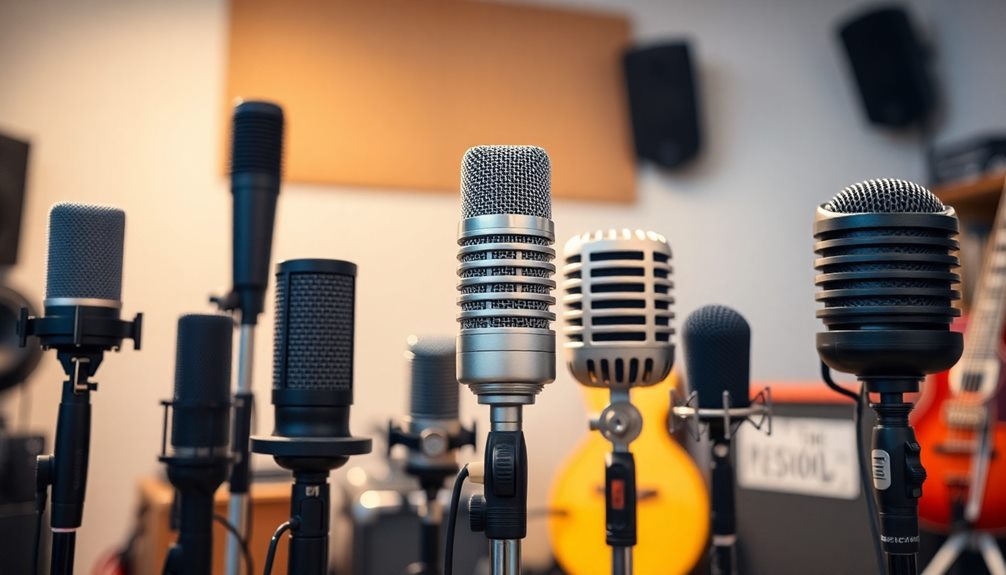
Microphone types vary widely, each designed to meet specific recording needs. One popular choice is the large diaphragm condenser microphone. These mics have a diaphragm bigger than 1 inch, making them perfect for capturing rich vocals in studio recording.
If you're working with acoustic instruments or need a flat frequency response, small diaphragm condenser microphones are your best bet. They've a diaphragm size less than 0.5 inches, ensuring accurate sound capture.
For film and broadcast, consider shotgun condenser microphones. With a long, narrow pickup pattern, they focus on sounds from a distance while keeping unwanted noise at bay.
If you're a podcaster or streamer, you might love USB condenser microphones. These are easy to use since they connect directly to your computer, making them ideal for home recording setups.
Choosing the Right Condenser Microphone
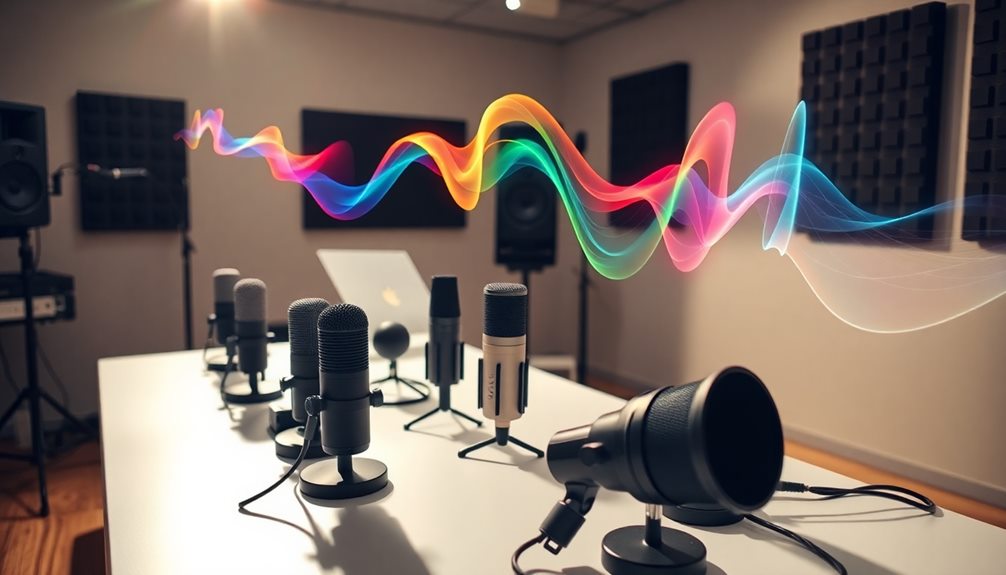
Choosing the right condenser microphone is essential for achieving the best sound quality in your recordings. You'll want to evaluate several important factors to make the best choice for your needs.
- Diaphragm size: Large-diaphragm models are great for vocals, giving you that warm sound. Small-diaphragm mics are perfect for capturing instruments accurately.
- Frequency response: Make sure it matches your sound source. For vocals, a range of 20 Hz to 20 kHz works wonders!
- Compatibility: Check if your microphone can connect with your audio setup. Most condenser mics need 48V phantom power and usually hook up via XLR cables.
- Recording environment: These mics shine in quiet, controlled spaces. If you're in a loud area, dynamic mics might be a better fit.
Don't forget to check for additional features like USB connectivity or onboard preamps, especially if you're a beginner or into podcasting.
Each of these elements will help you find the perfect condenser microphone to create fantastic recordings that you'll love!
Recommendations for Popular Models
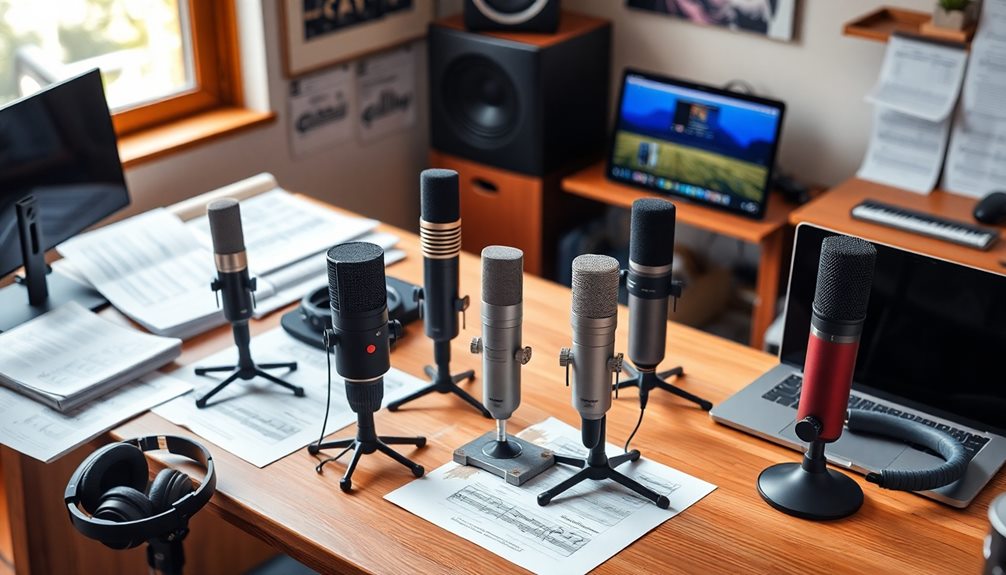
After you've evaluated your options and narrowed down your choices, it's time to explore some popular condenser microphone models that can elevate your recordings. These microphones can help you capture stunning vocals and acoustic instruments in studio settings.
| Model | Best For | Features |
|---|---|---|
| Neumann U87 | Professionals | Multiple polar patterns, clarity |
| Audio-Technica AT2020 | Home studios | Wide frequency response, affordable |
| Blue Yeti USB | Podcasters & streamers | Built-in headphone output, easy use |
The Neumann U87 is the industry standard, known for its exceptional clarity. If you're starting out, the Audio-Technica AT2020 offers great quality without breaking the bank. For those recording from home, the Blue Yeti USB is a favorite among podcasters for its versatility and ease of use. Finally, the Shure KSM32 is a durable large-diaphragm condenser that works well for both studio and live settings.
Each of these condenser microphones can greatly improve your recordings, making them clear and vibrant. Choose one that fits your needs, and get ready to enjoy the magic of sound!
Frequently Asked Questions
What Is the Difference Between a Condenser Mic and a Normal Mic?
A condenser mic's sensitivity captures subtle details and high frequencies, while a dynamic mic handles loud sounds better. You'll find condenser mics ideal for studio recordings, but dynamic mics are simpler for live performances.
Does a Condenser Mic Make You Sound Better?
You might think gear doesn't matter, but a condenser mic can truly enhance your sound. Its sensitivity captures your nuances and warmth, making your recordings clearer and more professional, so you'll definitely sound better.
What Instruments Are Condenser Microphones Used For?
You'll find condenser microphones perfect for capturing acoustic instruments like guitars, pianos, and strings. They excel with woodwinds and brass too, ensuring you hear every nuance and detail in your recordings, enhancing your overall sound quality.
What Not to Do With a Condenser Microphone?
Don't use a condenser microphone in noisy places; it'll pick up unwanted sounds. Avoid high sound pressure levels, rough handling, and using it without phantom power. Also, steer clear of uncontrolled live performance settings.
Conclusion
In the world of sound, a condenser microphone is like a magic wand, capturing every note and whisper with clarity! Whether you're recording music, podcasts, or voiceovers, these mics bring your voice to life. They're sensitive and versatile, perfect for different settings. Remember, picking the right one can make a big difference in your recordings. So, plunge into the exciting world of condenser microphones, and let your creativity shine through every sound you create!
